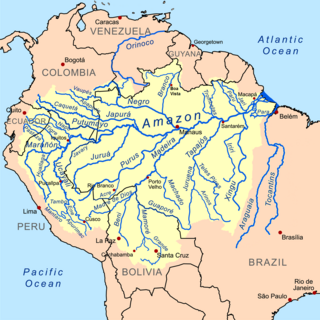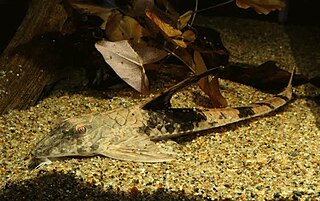
The Amazon basin is the part of South America drained by the Amazon River and its tributaries. The Amazon drainage basin covers an area of about 7,000,000 km2 (2,700,000 sq mi), or about 35.5 percent of the South American continent. It is located in the countries of Bolivia, Brazil, Colombia, Ecuador, Guyana, Peru, Suriname, and Venezuela, as well as the territory of French Guiana.

Hypostomus is a genus of catfish in the family Loricariidae. They are native to tropical and subtropical South America. H. plecostomus is the popular freshwater aquarium fish formerly known as Plecostomus plecostomus. The taxonomic structure of the Loricariidae is still being expanded by scientists. Hypostomus is a highly species-rich and widely distributed catfish genus.

Rineloricaria is a genus of freshwater tropical catfish belonging to the family Loricariidae. They are commonly called whiptail catfish because of the long filament that grows out of the tip of the caudal fin that is characteristic of the genus. With the exception of R. altipinnis from Panama, they are native to the rivers of northern and central South America. Some species are regularly seen in the aquarium trade.

Hemiancistrus is a genus of suckermouth armored catfishes. These species are native to South America. The taxonomy of this genus is complex and unclear, and major work has to be done. Many of these fish are popular aquarium fish.

The Hypoptopomatinae are a subfamily of catfishes of the family Loricariidae, composed of 17 genera and approximately 80 species. This subfamily represents about one-tenth of all loricariid species.
Harttia is a genus of armored catfishes native to South America.

Loricaria is a genus of armored catfish native to South America.

Parotocinclus is a genus of fish in the family Loricariidae native to South America. This genus is distributed through almost all hydrographic systems in South America from the Guyana Shield drainages and Amazon Shield tributaries to the coastal drainages of eastern and southeastern Brazil, including the rio São Francisco basin. Most species have the caudal peduncle oval in cross section. It has been found that Characidium species may interact with P. maculicauda. The small Characidium will follow grazing P. maculicauda, which release particulate matter dislodged from the catfish's foraging.
Dasyloricaria is a genus of armored catfishes native to Central and South America. The distribution of these species includes the northwestern South America on the Pacific slope of Colombia and Panama. Its distribution is restricted to the Pacific slope of the Andes, which is a unique pattern of distribution within the subfamily.
Gymnotocinclus anosteos is a species of armored catfish (Loricariidae) endemic to Brazil, where it is found in the Tocantinzinho River in the Tocantins River basin. This species grows to a length of 4.4 centimetres (1.7 in) SL.

Pseudobunocephalus is a genus of banjo catfishes.
Hypostomus cochliodon is a species of armored catfish native to the Paraguay and middle Paraná River basins in northern Argentina, southern Brazil and Paraguay. Initially it did not occur in the upper Paraná basin above the Guaíra Falls, but these disappeared after the construction of the Itaipu Dam, allowing this species to spread. It grows to a standard length of 23 cm (9.1 in).

Panaqolus is a genus of small catfish in the family Loricariidae native to rivers in tropical South America. Its members were formerly thought to belong to a clade of small-sized species in the genus Panaque, until this genus was separated from Panaque in 2001. At times it has been considered a subgenus of Panaque, and the validity of the genus has been disputed by various authors and sources. Pseudoqolus koko was formerly considered to be a member of this genus, although it was reclassified as a member of the currently monotypic genus Pseudoqolus by Nathan K. Lujan, Christian A. Cramer, Raphael Covain, Sonia Fisch-Muller, and Hernán López-Fernández following a 2017 molecular phylogenetic analysis.
Scott Allen Schaefer is an American ichthyologist working at the American Museum of Natural History as the dean of science for collections, exhibitions, and the public understanding of science; he serves as the curator-in-charge, in the department of ichthyology, within the division of vertebrate zoology.
Parotocinclus seridoensis is a species of catfish in the family Loricariidae. It is native to South America, where it occurs in the upper basin of the Piranhas River in Brazil. The specific epithet of this species, seridoensis, refers to the Caatinga ecoregion of Brazil where the species is found, which is reportedly locally known as "Sertão do Seridó". The species reaches 4.3 cm SL.
Hypostomus brevis is a species of catfish in the family Loricariidae. It is native to South America, where it is known from the Paraná River basin in Brazil. The species reaches 7.4 cm SL and is believed to be a facultative air-breather.
Loricaria luciae, sometimes known as Lucia's whiptail, is a species of catfish in the family Loricariidae. It is native to South America, where it occurs in the Paraguay River basin in Argentina, Bolivia, Brazil, and Paraguay, ranging south to the Paraguay's confluence with the Paraná River. It is typically found in habitats with flowing water, ranging in size from arroyos to large rivers, where it generally occurs at a depth of less than 1.5 m in environments with soft substrates. It is sometimes seen in riffles and blackwater areas. The species reaches 18.9 cm in standard length and is believed to be a facultative air-breather. Its specific epithet, luciae, honors Lúcia H. Rapp Py-Daniel of the National Institute of Amazonian Research for her contributions to loricariid taxonomy and systematics.
Loricaria pumila is a species of catfish in the family Loricariidae. It is native to South America, being known from Brazil, where it occurs in the Amazon River basin, near the mouths of the Tapajós and the Pará River, including the lower Tocantins River. It is reportedly typically found at depths between 3 and 29 m and distances of 15 to 1500 m from the shoreline, in environments characterized by a substrate of silt and organic detritus. An analysis of the stomach contents of a single individual found evidence of feeding on insects and aquatic insect larvae, as well as sand and detritus. The species reaches 8.1 cm in standard length and is believed to be a facultative air-breather. Its specific epithet, pumila, is derived from Latin and means "dwarf", referring to the small adult size of the species.
Loricaria spinulifera is a species of catfish in the family Loricariidae. It is native to South America, where it occurs in the Rio Negro basin in Brazil, including the Branco River and the Jauaperi River. It is typically seen in deep channels of blackwater rivers, where it is usually found at depths of 1.5 to 28 m and distances of 10 to 750 m from the shoreline. The environments in which the species occurs are characterized by substrates composed of sand, mud, and organic debris. Individuals of the species collected from deeper water tend to have smaller eyes and less prominent patterning than those collected from shallower areas. An analysis of the stomach contents of a single individual found evidence of feeding on aquatic insect larvae, as well as sand and detritus. The species reaches 13.8 cm in standard length and is believed to be a facultative air-breather. Its specific epithet, spinulifera, is derived from Latin and means "spine-bearing", referring to the conspicuous thorn-like odontodes found on its head.
Rineloricaria hoehnei is a species of catfish in the family Loricariidae. It is native to South America, where it occurs in the Paraguay River basin in Brazil. The species reaches 5.8 cm in standard length and is believed to be a facultative air-breather. In 2011, Rineloricaria hoehnei was found to be a probable junior synonym of Rineloricaria lanceolata, although FishBase recognizes both as distinct and valid species.








